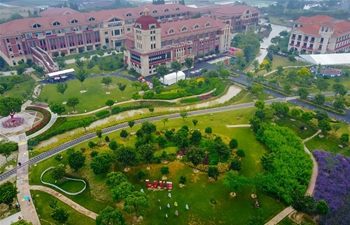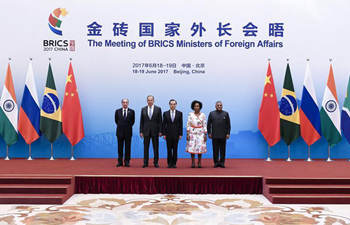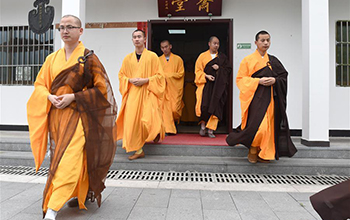SAN FRANCISCO, June 19 (Xinhua) -- Researchers at the University of Washington (UW) have measured a thin film made of a single type of conjugated polymer, a conducting plastic, as it interact with ions and electrons, which are relied on by biology and electronics respectively.
"Most of our technology relies on electronic currents, but biology transduces signals with ions, which are charged atoms or molecules," said David Ginger, professor of chemistry and chief scientist at the UW's Clean Energy Institute. "If you want to interface electronics and biology, you need a material that effectively communicates across those two realms."
In a paper published online Monday in Nature Materials, Ginger and his colleagues show how variations in the polymer layout yielded rigid and non-rigid regions of the film, and that these regions could accommodate electrons or ions - but not both equally. The softer, non-rigid areas were poor electron conductors but could subtly swell to take in ions, while the opposite was true for rigid regions.
Organic semiconducting polymers are complex matrices made from repeating units of a carbon-rich molecule. An organic polymer that can accommodate both types of conduction - ions and electrons - is the key to creating new biosensors, flexible bioelectronic implants and better batteries.
The team measured the physical and electrochemical properties of a film made out of poly(3-hexylthiophene), or P3HT, which is a relatively common organic semiconductor material. Lead author Rajiv Giridharagopal, a research scientist in the UW Department of Chemistry, probed the P3HT film's electrochemical properties in part by borrowing a technique originally developed to measure electrodes in lithium-ion batteries.
The approach, electrochemical strain microscopy, uses a needle-like probe suspended by a mechanical arm to measure changes in the physical size of an object with atomic-level precision. Giridharagopal discovered that, when a P3HT film was placed in an ion solution, certain regions of the film could subtly swell to let ions flow into the film. "This was an almost imperceptible swelling - just 1 percent of the film's total thickness," he said. "And using other methods, we discovered that the regions of the film that could swell to accommodate ion entry also had a less rigid structure and polymer arrangement."
More rigid and crystalline regions of the film could not swell to let in ions. But the rigid areas were ideal patches for conducting electrons.
Ginger, as the lead author, and his team wanted to confirm that structural variations in the polymer were the cause of these variations in electrochemical properties of the film. Co-author Christine Luscombe, a UW associate professor of materials science and engineering and member of the Clean Energy Institute, and her team made new P3HT films that had different levels of rigidity based on variations in polymer arrangement. By subjecting these new films to the same array of tests, Giridharagopal showed a clear correlation between polymer arrangement and electrochemical properties.
The less rigid and more amorphous polymer layouts yielded films that could swell to let in ions, but were poor conductors of electrons. More crystalline polymer arrangements yielded more rigid films that could easily conduct electrons.
These measurements demonstrate for the first time that small structural differences in how organic polymers are processed and assembled can have major consequences for how the film accommodates ions or electrons. It may also mean that this tradeoff between the needs of ion and electrons is unavoidable.
"The implication of these findings is that you could conceivably embed a crystalline material - which could transport electrons - within a material that is more amorphous and could transport ions," Ginger was quoted as saying in a news release from UW. "Imagine that you could harness the best of both worlds, so that you could have a material that is able to effectively transport electrons and swell with ion uptake - and then couple the two with one another."

















